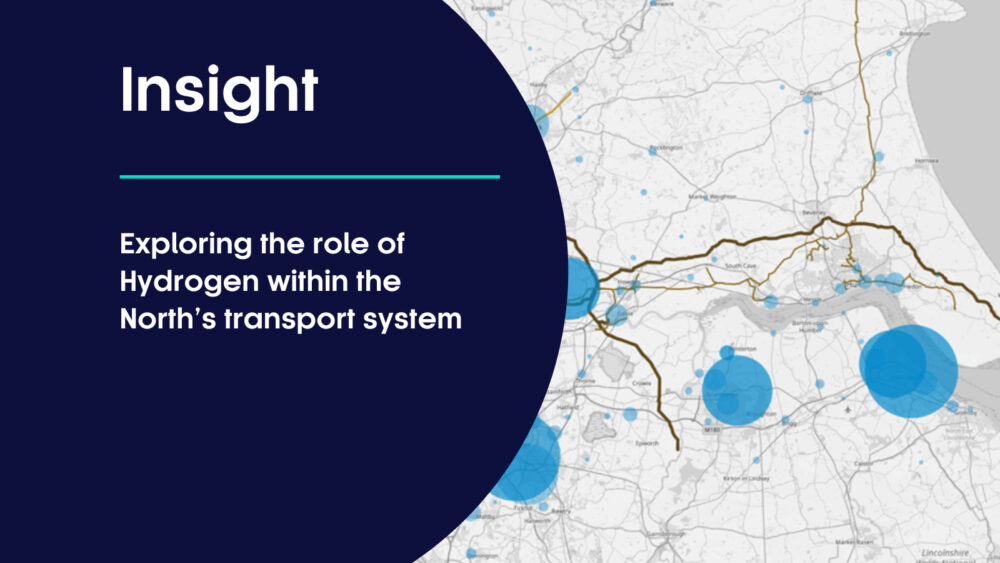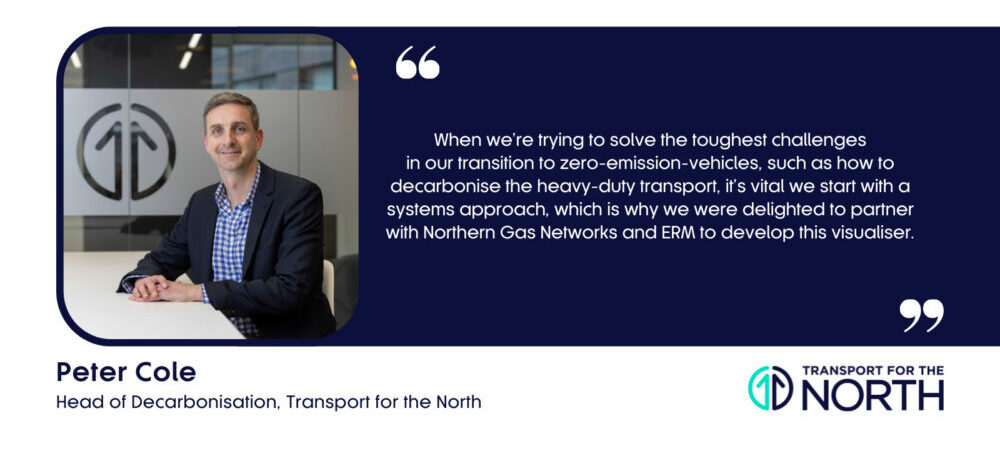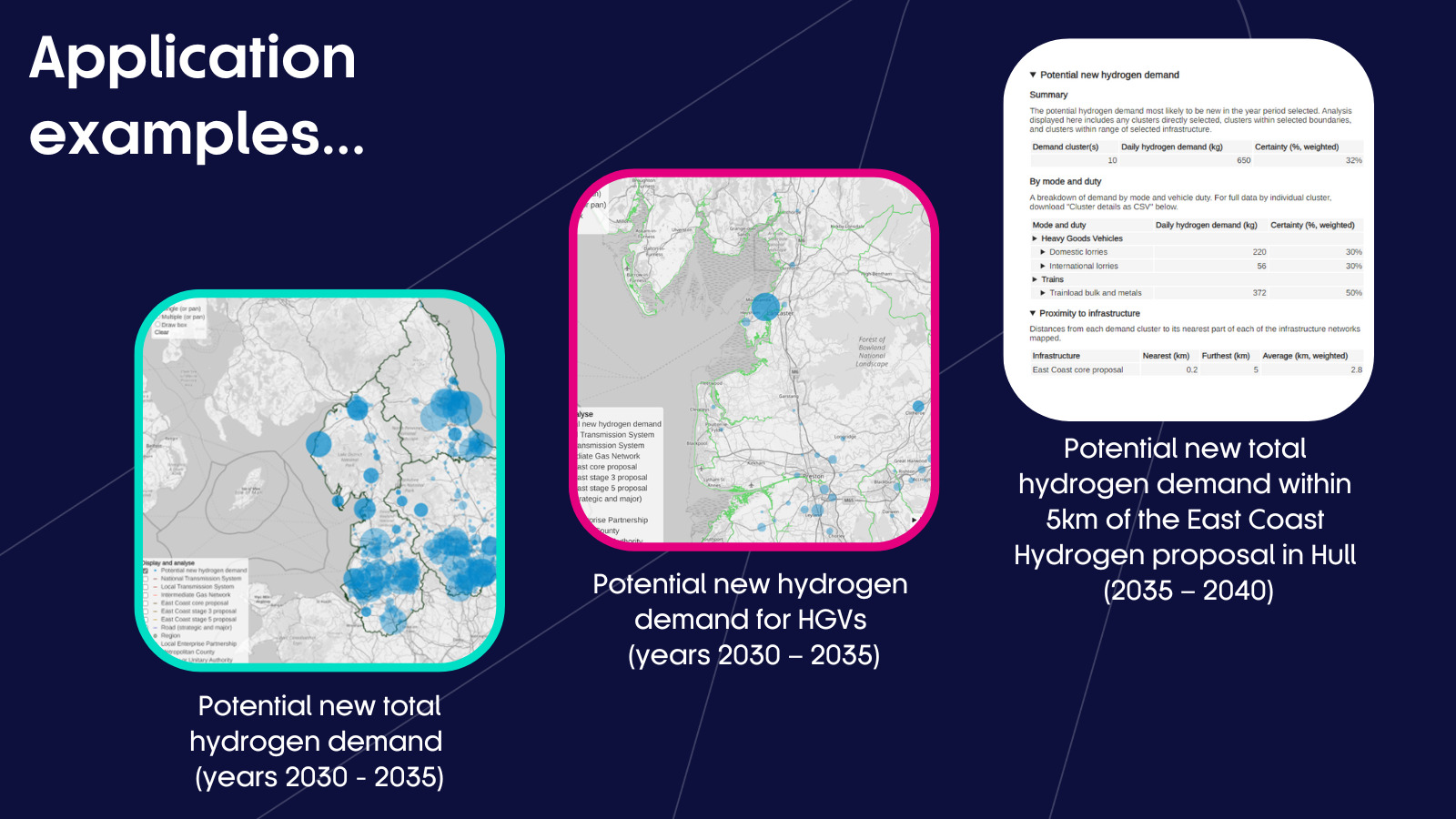
What is the North of England Hydrogen Mobility Visualiser?
The physics of hydrogen refuelling and electric vehicle charging are fundamentally different. The levels of certainty and industry development for both hydrogen production and hydrogen vehicles are several years behind the electric vehicle market.
It’s this uncertainty that has driven interest by TfN’s local authority partners and freight industry stakeholders to highlight the need for greater clarity on the potential for the use of hydrogen for transport in our region. It’s also led to the need for a pan-northern hydrogen transport refuelling study featuring as a priority activity for TfN within our Transport Decarbonisation Strategy, published in 2021.
Responding to this challenge, we employed a systems approach, working with Northern Gas Networks (NGN) and Environmental Resources Management (ERM), in developing the North of England Hydrogen Mobility Visualiser. The visualiser takes a cross-sectoral approach to visualising the potential for hydrogen refuelling in the North and is available at Hydrogen Mobility Visualiser (ermapps.com).
Through using the visualiser tool, users can…
As a result of the uncertainty surrounding the application of hydrogen for transport uses, the visualiser should not be used for pinpointing potential hydrogen refuelling sites, but rather to identify the approximate areas where the potential for hydrogen refuelling is greatest.
Early indications are that the tool is already returning value in this respect, with the East Coast Hydrogen project indicating that they plan to use the tool to aid the future development of their network, when assessing where potential hydrogen demand from transport may occur.
The tool can be easily updated to include future demand information, and future hydrogen supply and distribution plans can also be added and tested.
Who can use the visualiser tool?
Good news – the tool is publicly accessible to all!
Several potential users include…
How do you use the visualiser tool?
The visualiser presents blue circles on the map as approximate areas and volumes with realistic potential for hydrogen refuelling. Further analytical features within the tool can be used to further understand the risks and opportunities associated with these potential transport sector hydrogen demands.
A user guide for users of the tool outlines how to interpret information displayed within the visualiser, as well as several useful hints for using the tool.
A modelling method outlines the assumptions and methodology which have been followed in developing modal hydrogen demand and for building the tool.
What’s next for the visualiser tool?
TfN, NGN and ERM have been joint developers of the hydrogen visualiser, with the current version hosted by ERM and publicly accessible from TfN’s website for partners and interested parties to use. Further development of the tool might consider in greater detail the potential of hydrogen for long distance coach travel and rural bus services, providing a greater level of understanding of the risks, locations and technical solutions.
The model outputs could also be integrated with TfN’s Electric Vehicle Charging Infrastructure to flag locations where electricity grid connections are difficult and where hydrogen has a network advantage.
We hope that the visualiser proves useful in stimulating conversation and partnerships across the region, and indeed interested parties are welcome to scope and commission further development of the visualiser tool to cater at a better resolution, for their own specific user needs. Therefore, we would welcome users to interact with the tool and share comments on how the tool is beneficial to them and suggestions for future improvements which we can actively explore.

Commenting on the new tool, Peter Cole said, “When we’re trying to solve the toughest challenges in our transition to zero-emission-vehicles, such as how to decarbonise the heavy-duty transport, it’s vital we start with a systems approach, which is why we were delighted to partner with Northern Gas Networks and ERM to develop this visualiser.
“The outputs aren’t just driven by transport demand, but also the identification of those places where the supply and distribution of low carbon hydrogen makes most sense. We hope our partners and wider stakeholders find this evidence useful for kickstarting conversations at a local level to expedite the delivery of ZEV infrastructure on the ground.”
For further detail on TfN’s work within hydrogen and decarbonisation, please take a look at the relevant sections of our website or contact us.
